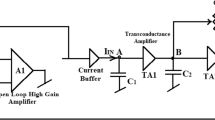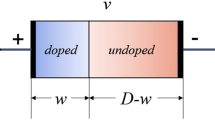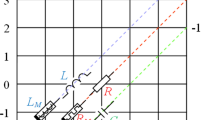Abstract
The paper discusses in detail the inability of a circuit designer to design a single input single element-controlled universal memelement emulator. A Single input Single element-controlled universal memelement emulator would be such a configuration that can provide the realization of any of the three memelements (Memristor/Memcapacitor/Meminductor) by taking a circuit element as inductor (L), Capacitor (C) or Resistor (R) with the same input port. The analysis shows that no such circuit configuration can be built to realize such a highly flexible universal memelement emulator. It is found that by using such structures, only two ideal memelements can be realized at maximum. If these circuit structures are used to realize the remaining third memelement, then, the resulting element comes out to be a non-ideal memelement. Two circuit configurations to demonstrate this theory are also included for both charge-controlled and flux-controlled memelement emulation based on the approaches shown in this paper.








Similar content being viewed by others
References
M.T. Abuelmaatti, Z.J. Khalifa, A new memristor emulator and its application in digital modulation. Analog Integrated Circuits Signal Process. 80(3), 577–584 (2014). https://doi.org/10.1007/s10470-014-0364-3
Y. Babacan, An operational transconductance amplifier-based memcapacitor and meminductor. Istanb. Univ. J. Electr. Electron. Eng. 18(1), 36–38 (2018). https://doi.org/10.5152/iujeee.2018.1806
Y. Babacan, A. Yesil, F. Kacar, Memristor emulator with tunable characteristic and its experimental results. AEU Int. J. Electron. Commun. 81, 99–104 (2017). https://doi.org/10.1016/j.aeue.2017.07.012
B. Bao, Z. Ma, J. Xu, Z. Liu, Q. Xu, A simple memristor chaotic circuit with complex dynamics. Int. J. Bifurc. Chaos 21(09), 2629–2645 (2011). https://doi.org/10.1142/s0218127411029999
B.-C. Bao, J.-P. Xu, G.-H. Zhou, Z.-H. Ma, L. Zou, Chaotic memristive circuit: equivalent circuit realization and dynamical analysis. Chin. Phys. B 20(12), 120502 (2011). https://doi.org/10.1088/1674-1056/20/12/120502
K. Bhardwaj, M. Srivastava, New multiplier-less compact tunable charge-controlled memelement emulator using grounded passive elements. Circuits Syst. Signal Process. 41(5), 2429–2465 (2021). https://doi.org/10.1007/s00034-021-01895-3
K. Bhardwaj, M. Srivastava, New electronically adjustable memelement emulator for realizing the behaviour of fully-floating meminductor and memristor. Microelectron. J. 114, 1051 (2021). https://doi.org/10.1016/j.mejo.2021.105126
K. Bhardwaj, M. Srivastava, On the investigation of frequency-related fingerprints of meminductor/capacitor and their duals realized by circuit emulators. Radioengineering 31(3), 374–381 (2022). https://doi.org/10.13164/re.2022.0374
K. Bhardwaj, M. Srivastava, New grounded passive elements-based external multiplier-less memelement emulator to realize the floating meminductor and memristor. Analog Integr. Circuits Signal Process. 110(3), 409–429 (2022). https://doi.org/10.1007/s10470-021-01976-y
D. Biolek, V. Biolková, Z. Kolka, J. Dobeš, Analog emulator of genuinely floating memcapacitor with piecewise-linear constitutive relation. Circuits Syst. Signal Process. 35(1), 43–62 (2015). https://doi.org/10.1007/s00034-015-0067-8
Z.G. Çam Taşkıran, M. Sağbaş, U.E. Ayten, H. Sedef, A new universal mutator circuit for memcapacitor and meminductor elements. AEU Int. J. Electron. Commun. 119, 153180 (2020). https://doi.org/10.1016/j.aeue.2020.153180
L. Chua, Memristor—the missing circuit element. IEEE Trans. Circuit Theory 18(5), 507–519 (1971). https://doi.org/10.1109/tct.1971.1083337
F. Corinto, A. Ascoli, Memristive diode bridge with LCR filter. Electron. Lett. 48(14), 824 (2012). https://doi.org/10.1049/el.2012.1480
T. Driscoll, Y.V. Pershin, D.N. Basov, M. Di Ventra, Chaotic memristor. Appl. Phys. A 102(4), 885–889 (2011). https://doi.org/10.1007/s00339-011-6318-z
A.S. Elwakil, M.E. Fouda, A.G. Radwan, A simple model of double-loop hysteresis behavior in memristive elements. IEEE Trans. Circuits Syst. II Express Briefs 60(8), 487–491 (2013). https://doi.org/10.1109/tcsii.2013.2268376
G. Ferri, N.C. Guerrini, Low-Voltage Low-Power CMOS Current Conveyors (Kluwer Academic Publishers, Boston, 2003)
M.E. Fouda, A.G. Radwan, Charge controlled memristor-less memcapacitor emulator. Electron. Lett. 48(23), 1454 (2012). https://doi.org/10.1049/el.2012.3151
K. Kaewdang, K. Kumwachara, W. Surakampontom, Electronically tunable floating CMOS resistor using OTA, in IEEE International Symposium on Communications and Information Technology, 2005. ISCIT (2005).https://doi.org/10.1109/iscit.2005.1566957
Z. Li, Y. Zeng, M. Ma, A novel floating memristor emulator with minimal components. Act. Passiv. Electron. Compon. 2017, 1–12 (2017). https://doi.org/10.1155/2017/1609787
B. Muthuswamy, Implementing memristor based chaotic circuits. Int. J. Bifurc. Chaos 20(05), 1335–1350 (2010). https://doi.org/10.1142/s0218127410026514
R.K. Ranjan, N. Raj, N. Bhuwal, F. Khateb, Single DVCCTA based high frequency incremental/decremental memristor emulator and its application. AEU Int. J. Electron. Commun. 82, 177–190 (2017). https://doi.org/10.1016/j.aeue.2017.07.039
R.K. Ranjan, N. Rani, R. Pal, S.K. Paul, G. Kanyal, Single CCTA based high frequency floating and grounded type of incremental/decremental memristor emulator and its application. Microelectron. J. 60, 119–128 (2017). https://doi.org/10.1016/j.mejo.2016.12.004
F.J. Romero et al., Memcapacitor emulator based on the Miller effect. Int. J. Circuit Theory Appl. 47(4), 572–579 (2019). https://doi.org/10.1002/cta.2604
F.J. Romero, M. Escudero, A. Medina-Garcia, D.P. Morales, N. Rodriguez, Meminductor emulator based on a modified Antoniou’s Gyrator circuit. Electronics 9(9), 1407 (2020). https://doi.org/10.3390/electronics9091407
M.P. Sah, R.K. Budhathoki, C. Yang, H. Kim, Charge controlled meminductor emulator. JSTS J. Semicond. Technol. Sci. 14(6), 750–754 (2014). https://doi.org/10.5573/jsts.2014.14.6.750
M.P. Sah, R.K. Budhathoki, C. Yang, H. Kim, Mutator-based meminductor emulator for circuit applications. Circuits Syst. Signal Process. 33(8), 2363–2383 (2014). https://doi.org/10.1007/s00034-014-9758-9
C. Sánchez-López, L.E. Aguila-Cuapio, A 860 kHz grounded memristor emulator circuit. AEU Int. J. Electron. Commun. 73, 23–33 (2017). https://doi.org/10.1016/j.aeue.2016.12.015
F. Setoudeh, M.M. Dezhdar, A new design and implementation of the floating-type charge-controlled memcapacitor emulator. Majlesi J. Telecommun. Devices (2020).
P.K. Sharma, R.K. Ranjan, F. Khateb, M. Kumngern, Charged controlled mem-element emulator and its application in a chaotic system. IEEE Access 8, 171397–171407 (2020). https://doi.org/10.1109/access.2020.3024769
X.-Y. Wang, A.L. Fitch, H.H.C. Iu, V. Sreeram, W.-G. Qi, Implementation of an analogue model of a memristor based on a light-dependent resistor. Chin. Phys. B 21(10), 108501 (2012). https://doi.org/10.1088/1674-1056/21/10/108501
S. Wen, Yi. Shen, Z. Zeng, Y. Cai, Chaos analysis and control in a chaotic circuit with a PWL memristor. Int. Conf. Inf. Sci. Technol. (2011). https://doi.org/10.1109/icist.2011.5765147
S. Yaner, H. Kuntman, Fully CMOS memristor based chaotic circuit. Radioengineering 23, 1140–1149 (2014)
D. Yu, X. Zhao, T. Sun, H.H.C. Iu, T. Fernando, A simple floating mutator for emulating memristor, memcapacitor, and meminductor. IEEE Trans. Circuits Syst. II Express Briefs 67(7), 1334–1338 (2020). https://doi.org/10.1109/tcsii.2019.2936453
F. Yuan, Y. Li, G. Wang, G. Dou, G. Chen, Complex dynamics in a memcapacitor-based circuit. Entropy 21(2), 188 (2019). https://doi.org/10.3390/e21020188
F. Yuan, Y. Deng, Y. Li, A multistable generalized meminductor with coexisting stable pinched hysteresis loops. Int. J. Bifurc. Chaos 30(02), 2050023 (2020). https://doi.org/10.1142/s0218127420500236
Q. Zhao, C. Wang, X. Zhang, A universal emulator for memristor, memcapacitor, and meminductor and its chaotic circuit. Chaos Interdiscip. J. Nonlinear Sci. 29(1), 013141 (2019). https://doi.org/10.1063/1.5081076
Funding
Not applicable.
Author information
Authors and Affiliations
Corresponding author
Ethics declarations
Conflict of interest
The authors declare that they have no conflict of interest.
Additional information
Publisher's Note
Springer Nature remains neutral with regard to jurisdictional claims in published maps and institutional affiliations.
Rights and permissions
Springer Nature or its licensor (e.g. a society or other partner) holds exclusive rights to this article under a publishing agreement with the author(s) or other rightsholder(s); author self-archiving of the accepted manuscript version of this article is solely governed by the terms of such publishing agreement and applicable law.
About this article
Cite this article
Bhardwaj, K., Srivastava, M. On the Boundaries of the Realization of Single Input Single Element-Controlled Universal Memelement Emulator. Circuits Syst Signal Process 42, 6355–6366 (2023). https://doi.org/10.1007/s00034-023-02420-4
Received:
Revised:
Accepted:
Published:
Issue Date:
DOI: https://doi.org/10.1007/s00034-023-02420-4




